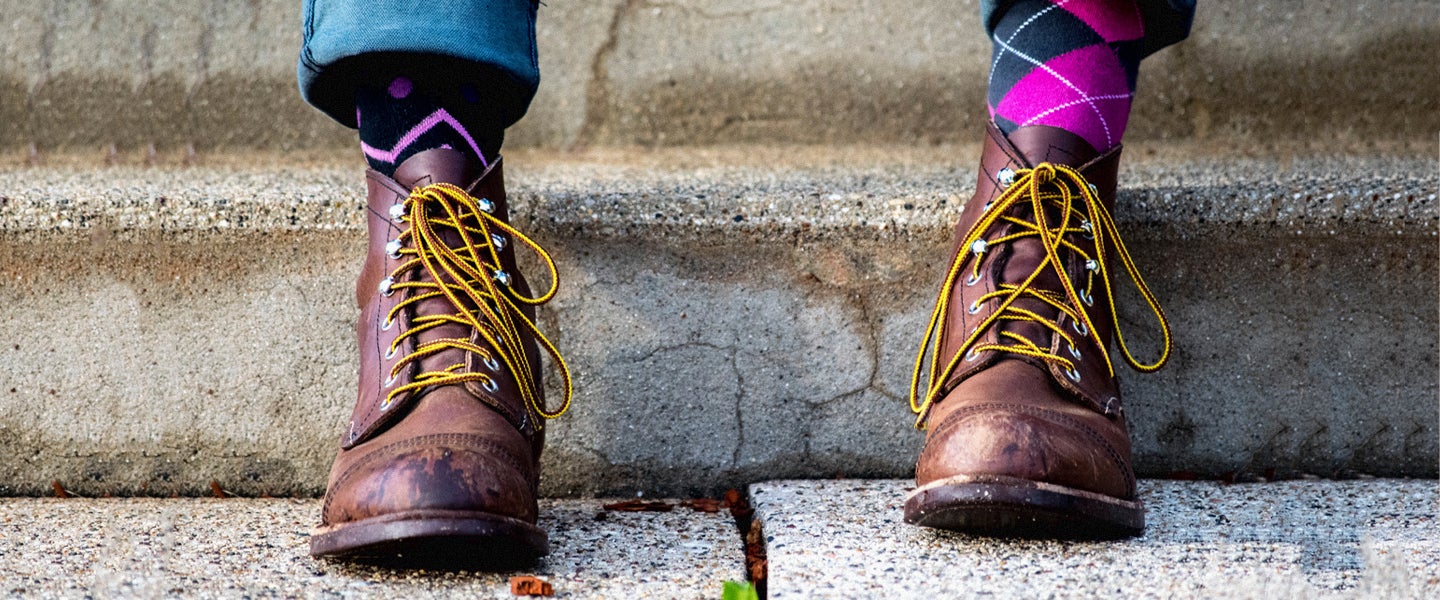Alexine, a 23-year-old woman from Oregon, explains the sartorial choices she makes to present as bisexual. “I definitely go in for the standards: I never met a pair of trousers I didn’t cuff and a shirt I didn’t try to tuck in, and apparently I’m incapable of sitting forward in a chair like a normal person,” Alexine, a pseudonym, tells me. “I’m also definitely a bobbed-hair-and-statement-jewelry bi, and a fineline-black-tattoos-and-clogs bi, and a green-tea-and-linen bi.”
Taylor, a 28-year-old Canadian man who identifies as pansexual, tells me he indicates his sexuality through “horn-rimmed glasses, button-downs rolled up to just below the elbow and an incomparable combination of feminine colors” with leather. For Aaron, a bisexual man in his late 30s in London, the following works: “I wear a lot of hot pink, colorful Jeremy Scott winged shoes and little rainbow pins, as well as letting myself come across as a little effusive and camp.”
Happy #BiVisibilityDay. Here's my favorite parts of our culture:
– nose rings
– inability to sit in chairs
– bob haircuts
– "should i dye my hair blue again?"
– Sylvia Plath
– cuffed jeans
– going to Warped Tour as a teen
– Vanessa Carlton— Kirsten King (@KirstenKing_) September 23, 2019
Presenting as bisexual is inherently difficult: There are few stylistic shorthands that set bisexuals apart from monosexuals, and both “dressing gay” and “dressing straight” conceal aspects of their identity. Last year, Autostraddle praised the “bisexual bob” as a signifier, but this is more useful for bisexual women than men, who probably won’t be asking their barbers for “the Eleanor Shellstrop.” More gender-inclusive is the memeable observation that bisexuals can’t sit properly in chairs (i.e., they “can’t sit straight”), but like iced coffee being gay and finger guns being “bi culture,” people who aren’t young and/or hyper-online probably won’t recognize it as a queer signifier.
Curious as to how bisexual people navigate this difficulty, I spoke to more than 100 bisexual men, women and non-binary people about the sartorial choices they make to identify their sexuality. Among the answers, certain themes start to emerge, the following cropping up most often:
- Cuffing jeans and trousers
- Buttoned shirts done up all the way to the top
- Flannel and plaid
- French tucking
- Doc Martens, Birkenstocks, Converse and Vans footwear
- Backwards hats
- Leather jackets
- Denim jackets with jeans
- Mixing black and pink
- Tattoos, especially floral tattoos
- Facial piercings and mismatched earrings
Hair is, of course, an important marker of sexuality, and undercuts and partially-shaved hair are popular choices among my sources, as is dyeing it one or more of the colors of the bisexual flag (i.e. pink, blue and purple). “My hair was always a battle with my mom who made me wear it long,” Mo, a 30-year-old bisexual woman in Minneapolis, explains. “It felt like an act of control over my body to have no hair. People, especially men, stopped talking to me on the street. I bought a baseball cap and felt really queer for the first time.” She adds that she experimented with growing out her body hair, another indicator that comes up often among the bisexual women and AFAB non-binary people I talked to.
A few of the bisexual indicators tend to be gender-specific, such as blazers, suits, short haircuts and underarm hair on (people perceived as) women, and makeup and nail polish on (people perceived as) men. Many of them are adopted wholesale from gay and lesbian culture. For example, shorter hair, flannel shirts and tattoos on women and AFAB non-binary people have been used in lesbian communities for years — i.e., they’re not unique bisexual identifiers — and the same is true of gay signifiers like makeup and nail polish adopted by bisexual men and AMAB non-binary people.
That said, some bisexuals resist adopting gay and lesbian signifiers, especially if they aren’t out, live or work in homophobic areas or are trying to ID as non-monosexual. “It’s hard because there aren’t many ways to present as bi that won’t just be read as gay,” Sarah, a 25-year-old bisexual woman from Indiana, tells me. “My [bisexual] partner has expressed interest in painting his nails but worries about how that would translate in professional circles and in his conservative hometown.” On the topic of nails, Samantha, a 26-year-old bisexual woman in Seattle, says she’s stopped getting acrylic nails “because a few of my gay friends read them as a signal that I’m not ready to… uh, “get my hands dirty.”
Like several of my sources, Samantha says wearing the bisexual flag on an enamel pin is the most straightforward way she’s found to communicate her sexuality, even though it’s “not immediately legible to some of the women I’m trying to flag myself for.” Many others have become adept code-switchers, presenting as more gay in LGBTQ-friendly spaces and blending in as straight in conservative and homophobic environments.
Men and AMAB non-binary people were particularly likely to say they struggle with presenting as bisexual and that their signifiers are read as gay (bisexual women, on the other hand, say their bisexual dress is often read as “alt” or “quirky” but straight; “fashion thrift tomboy” is how one woman puts it). “It’s impossible for me to present as a bisexual — there’s no “tell”,” says Avery, a pseudonymous 31-year-old bisexual man based in Kentucky. He says it’s irritating how often he has to explain that he’s not gay but rather attracted to people of all genders, concluding that “to be bisexual is to be frustrated.”
Jon, a “fortysomething” bisexual man in the Bay Area, has an even bleaker outlook. ”I’m too old, too indoctrinated and too late in realizing my sexuality to appear as anything other than straight, and I hate every minute of it,” they tell me. “The one selection of out-ness I can wear without feeling like a fraud is a rainbow Star Trek pin attached to my work bag — anything else feels fake or like I’m trying too hard to fit in.”
Many of my sources are non-binary and tell me that this informs their sartorial presentation. ”My bisexuality and non-binaryness are deeply linked,” Basil, a 27-year-old living in Philadelphia, explains. “I wear a lot of boots in unseasonable weather with socks too high, and a giant floppy hat.” Presenting as non-binary often overlaps with presenting as non-heterosexual; a cisgender, bisexual man might dress like an AMAB non-binary person by wearing (say) nail polish, makeup or pink — another reason specifically bisexual signifiers are hard to come by.
Some bisexuals tell me they don’t mind being misidentified as gay so long as they’re read as part of the LGBTQ community, while others find it insulting to have their bisexuality erased. However, even coding oneself as part of the community isn’t as straightforward as it once was. As many of my sources note, LGBTQ signifiers like mesh, butch chic and the bondage harness are routinely co-opted by fashion-forward heterosexuals until they lose their status as “a gay thing.” Plus, the community’s emphasis on inclusion probably means that queer signifiers will always be in flux. ”The LGBTQ community is both uniquely adept at developing and crowning specific cultural signifiers and also at subsequently deconstructing those signifiers, in the spirit of inclusion,” Riese, the editor-in-chief and co-founder of Autostraddle, writes, “until they are entirely unspecific and encompass a vast range of expression.”
All of this means that it will likely always be hard to dress obviously and specifically as bisexual — a sartorial difficulty some say echoes the hardships of bisexuality more generally, marked as it is by popular misunderstanding and disbelief. Malorie, a 32-year-old bisexual woman in Idaho, sums it up as follows: “I have no idea how to present myself or even exist within spaces, and isn’t that honestly the most bisexual thing ever?”

